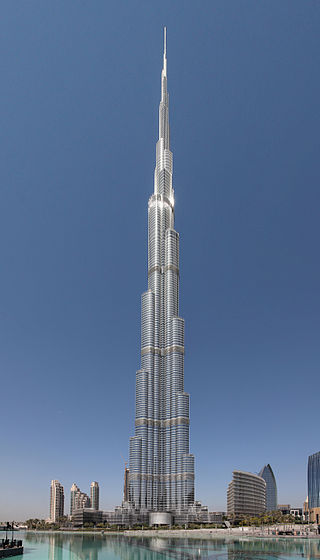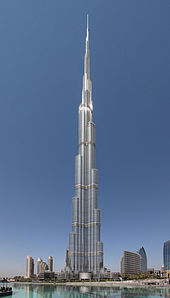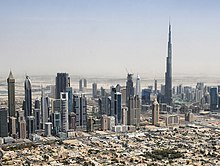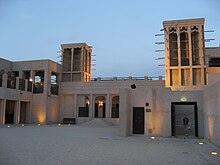
The United Arab Emirates, or simply the Emirates, is a country in West Asia and the Middle East. It is located at the eastern end of the Arabian Peninsula and shares borders with Oman and Saudi Arabia, while also having maritime borders in the Persian Gulf with Qatar and Iran. Abu Dhabi is the country's capital, while Dubai, the most populous city, is an international hub.

Dubai is the most populous city in the United Arab Emirates (UAE) and the capital of the Emirate of Dubai, the most populated of the country's seven emirates.

The Burj Khalifa is a skyscraper in Dubai, United Arab Emirates. It is the world's tallest structure. With a total height of 829.8 m and a roof height of 828 m (2,717 ft), the Burj Khalifa has been the tallest structure and building in the world since its topping out in 2009, supplanting Taipei 101, the previous holder of that status.

E 11 is a highway in the United Arab Emirates (UAE). The longest road in the Emirates, it stretches from the Al Batha border crossing at the Saudi Arabia–UAE border in al-Silah in the al-Dhafra region of the Emirate of Abu Dhabi and ends at the Oman–UAE border crossing of al-Darah in al-Jeer, Emirate of Ras al-Khaimah, running roughly parallel to UAE's coastline along the Persian Gulf. The road forms the main artery in some emirates' main cities, where it assumes various alternate names —Sheikh Maktoum Bin Rashid Road and Sheikh Khalifa bin Zayed Road in Abu Dhabi, Sheikh Zayed Road in Dubai, Al Ittihad Road in Sharjah Emirate and Ajman Emirate, and Sheikh Muhammad bin Salem Road in Ras al-Khaimah.
Bani Yas is a tribal confederation of Najdi origin in the modern United Arab Emirates. The tribal coalition consists of tribes from Dubai to Khawr al Udayd southeast of Qatar, was called the Bani Yas Coalition. Al Nahyan, a branch of Al Falahi, leads the tribe and is the ruling family of the Abu Dhabi. Al Maktoum, a branch of Al Falasi, is also a member and is the ruling family of Dubai. Al Nahyan and Al Maktoum are the most influential in the UAE federal government, and Abu Dhabi and Dubai have the right to veto any federal legislation. The ruler of Abu Dhabi is customarily elected as the president of the UAE, and the ruler of Dubai is traditionally elected as the vice president and prime minister of the UAE.

The Sheikh Zayed Grand Mosque is located in Abu Dhabi, the capital city of the United Arab Emirates. It is the country's largest mosque, and is the key place of worship for daily Islamic prayers. There is a smaller replica of this mosque in Surakarta, a city in Indonesia.
The earliest written record of Dubai (Dibei) is accredited to Muhammad al-Idrisi, who mapped the coast of the UAE in the tenth century AD. Circa 1580, the state jeweler of Venice, Gasparo Balbi, documented the pearling industry of Dubai and other cities currently presiding in UAE territory. Though traditionally conservative, the UAE is one of the most liberal countries in the Gulf, with other cultures and beliefs generally tolerated. Politically it remains authoritarian, however, relations with neighbouring Iran have been tense because of an ongoing territorial dispute over Gulf islands. The UAE was one of only three countries to recognise Taliban rule in Afghanistan.
The government of Dubai took a decision to diversify from a trade-based, oil-reliant economy to one that is service and tourism-oriented. This has made real estate and other developments more valuable, thus resulting in a property boom from 2004 to 2006. Construction on a large scale has turned Dubai into one of the fastest-growing cities in the world. There are a number of large-scale projects which are currently under construction or are to be constructed in the future. Due to the heavy construction which is taking place in Dubai, 30,000 construction cranes, which are 25% of cranes worldwide, are operating in Dubai. Due to the burst of construction, Dubai has acquired various building-related records, which include: the world's tallest tower, the world's largest shopping mall, the world's largest fountain and the world's tallest hotel. Also under construction is Dubailand, which will be almost twice the size of the Walt Disney World Resort.
The history of the Jews in the United Arab Emirates describes the historical and modern presence of Jews over the millennia in the Middle East and the recorded meetings with Jewish communities in areas that are today in the geographic territories of the United Arab Emirates.
The World Trade Center Abu Dhabi is a complex of two skyscrapers in Abu Dhabi, United Arab Emirates. Construction of these towers was scheduled to end in 2010, though the 2008 financial crisis pushed the project completion date to 2014. The complex includes two malls, and one Courtyard by Marriott hotel. The complex was initially planned to house three skyscrapers, but the 2008 crisis forced the contractors to withdraw construction of the Hotel Tower, the result being two skyscrapers.

Abu Dhabi is the capital of the United Arab Emirates. It is also the capital of the Emirate of Abu Dhabi and the centre of the Abu Dhabi Metropolitan Area. Abu Dhabi is the UAE's second-most populous city after Dubai.

The culture of the United Arab Emirates'‘ ' is part of the culture of Eastern Arabian. Its historical population was a small tribal community that changed with the arrival of an influx of foreign nationals in the mid-20th century. Emirati culture is a blend of Arabian, Islamic, and Persian cultures, with influences from the cultures of East Africa and Indian Subcontinent. Islam has had a prominent influence on local architecture, music, attire, cuisine, and lifestyle.

Al Bahr Towers is a development in the emirate of Abu Dhabi consisting of two 29-storey, 145m–high towers. It is located at the intersection of Al Saada and Al Salam Street in Abu Dhabi City, the capital of the United Arab Emirates, at the eastern entrance. One tower houses the new headquarters of the Abu Dhabi Investment Council (ADIC), an investment arm of the Government of Abu Dhabi. The other serves as the head office of Al Hilal Bank, a progressive and innovative Islamic Bank.

Jalal Jamal Majid Bin Thaneya Al Marri (born February 26, 1986) is an Emirati activist from Dubai, United Arab Emirates. He is known for his movements and campaigns towards children and adults with special needs. Since 2006, he has been publicly fund-raising and campaigning to increase the awareness for people with special needs.
Binghatti Properties is an Emirati real estate development company founded in 2008 with its headquarters in Dubai, United Arab Emirates. The company focuses on real estate, hospitality, and construction.













